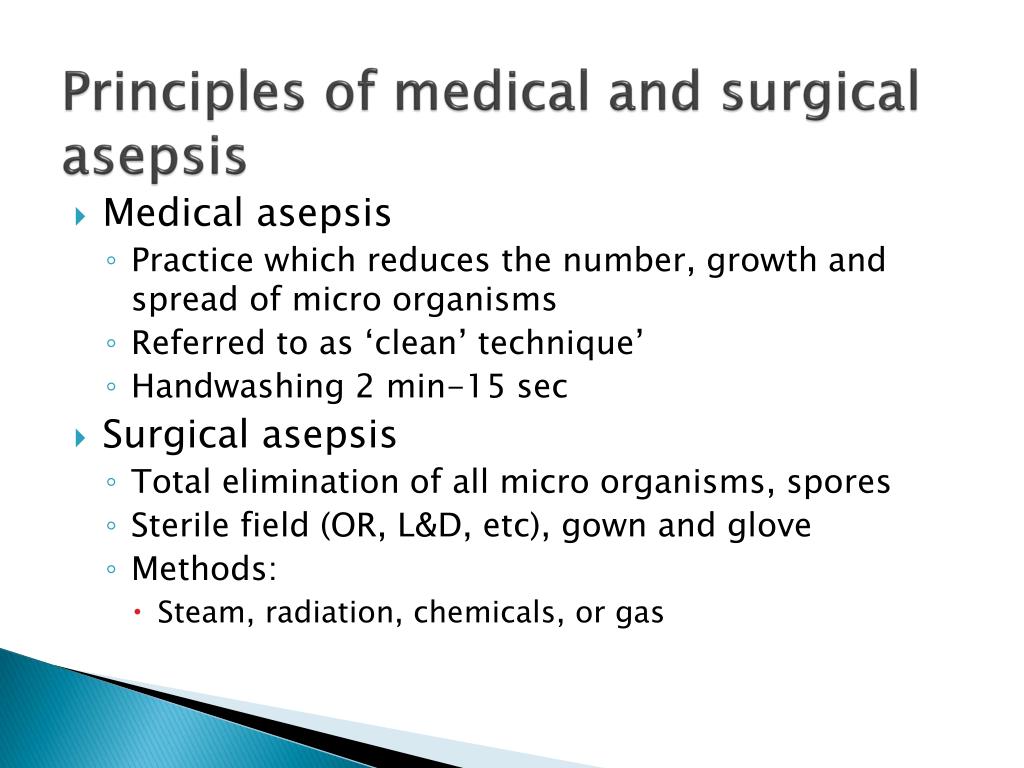

The back of the gown is not considered sterile even if it is a wraparound gown.ĭrapes covering instrument tables or the patient should be moisture proof. Gowns are sterile from mid-chest to waist and from gloved hand to 2 inches above the elbow. Items hanging over the table edge are considered nonsterile because they are out of the surgeon’s vision. Sterile tables are sterile only at table height. Nonsterile, contaminated equipment may be a source of cross-contamination. If the sterility of an item is questioned, it is considered contaminated. Nonscrubbed personnel and nonsterile items may be sources of cross-contamination. Scrubbed personnel handle only sterile items nonscrubbed personnel handle only nonsterile items.

Unsterile instruments may be a source of cross-contamination. Scrubbed team members face each other and the sterile field at all times.Ī team member’s back is not considered sterile even if wearing a wraparound gown.Įquipment used during surgery must be sterilized. Nonscrubbed personnel do not reach over sterile fields.ĭust, lint, or other vehicles of bacterial contamination may fall on the sterile field. Movement in the OR may encourage turbulent airflow, resulting in cross-contamination. Movement in the operating room (OR) by all personnel is kept to a minimum only necessary personnel should enter the operating room. Talking releases moisture droplets laden with bacteria. Movement out of the sterile area may encourage cross-contamination. Surgical team members remain within the sterile area. The differences in time and cost involved for sterile technique versus clean technique can be substantial. 1217-1218) performed under sterile technique might require the use of sterile gloves, a sterile patient preparation kit, and a small drape, whereas the same procedure performed using clean or aseptic technique would require only nonsterile gloves and an alcohol wipe. Studies in human surgical practice have attempted to determine when sterile technique versus clean technique is necessary for certain minor procedures. The higher level of protection in a sterile field is critical because the natural defenses of the patient are breached by surgical incision, puncture, or introduction of instruments into the vascular system. Sterile technique (see Box 1-1) applies to work performed in a sterile field. When specific procedures are discussed, aseptic technique has been referred to as clean technique. The complete absence of microorganisms cannot be achieved in a hospital environment, but use of aseptic techniques substantially aids in control of pathogens and decreases the risk of infection for patients and staff. Modified from Philips N: In: Berry and Kohn’s operating room technique, ed 11, St Louis, Mo., 2007, Mosby. Procedures carried out for the destruction of pathogens at the end of the surgical procedure in the operating room (OR) after the patient has been removed. Method by which contamination with microorganisms is prevented to maintain sterility throughout the surgical procedure. Procedures followed to protect personnel from contact with the blood and body fluids of patients.Īrea around the site of incision into tissue or the site of introduction of an instrument into a body orifice that has been prepared using sterile supplies and equipment.

Item is sterile to its highest degree.Īwareness of sterile, unsterile, clean, and contaminated areas, objects, and individuals and their proximity to each other. Transmission of microorganisms from patient to patient or from inanimate object to patient.Ĭleaning and disinfecting or sterilizing processes carried out to make contaminated items safe to handle.Ĭhemical or mechanical (friction) destruction of pathogens. Method to prevent contamination by microorganisms.Ī material used to reduce or inhibit the migration or transmission of microorganisms in the environment: personnel attire and gowns, furniture and patient drapes, equipment and supply packaging, and ventilating filters.
MEDICAL DEFINITION OF MEDICAL ASEPSIS SKIN
Used primarily on skin to stop the growth of resident flora.Ībsence of microorganisms that cause disease. Inorganic chemical compounds that combat sepsis by inhibiting the growth of microorganisms without necessarily killing them.

Prevention of sepsis by exclusion, destruction, or inhibition of growth or multiplication of microorganisms from body tissues and fluids.


 0 kommentar(er)
0 kommentar(er)
